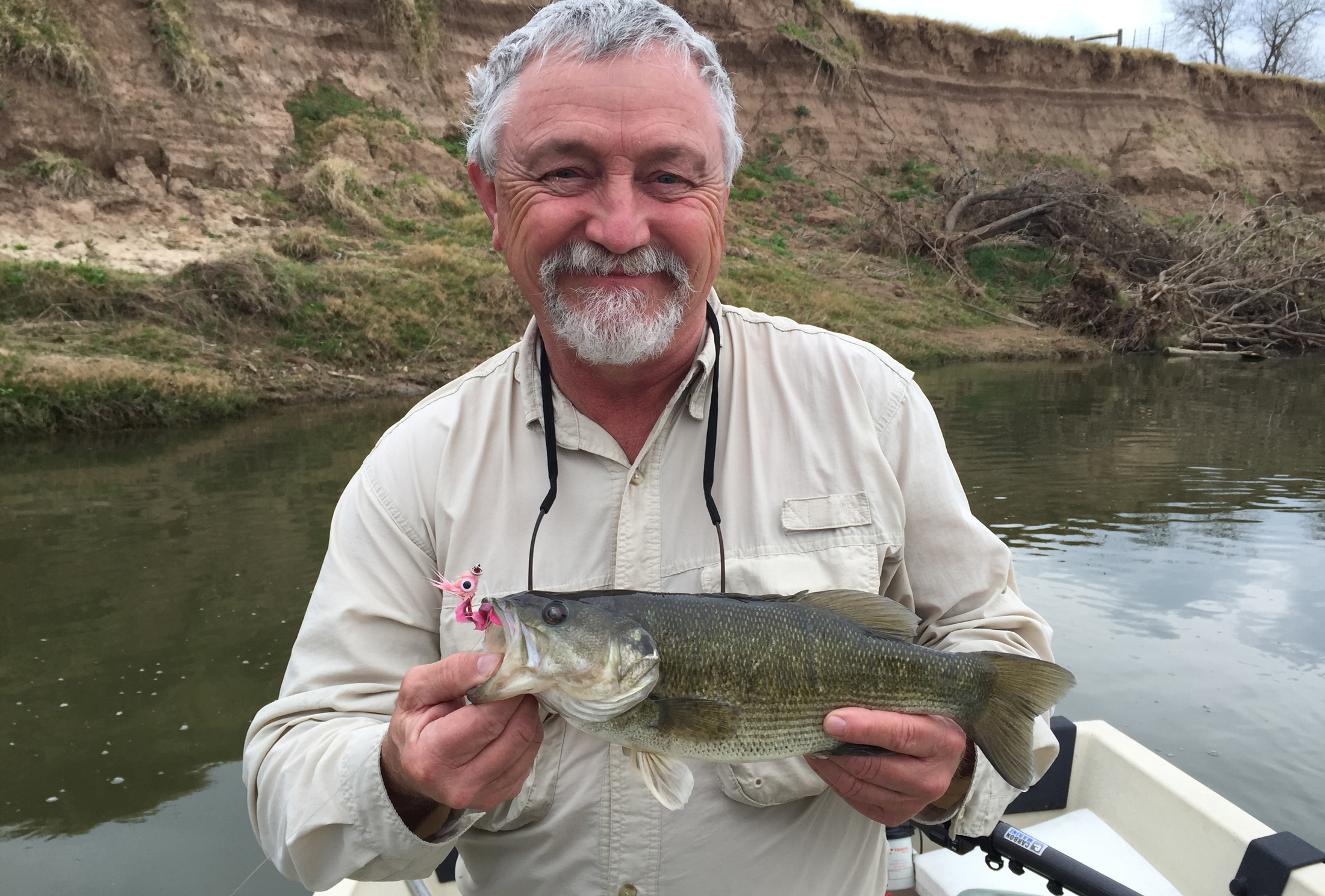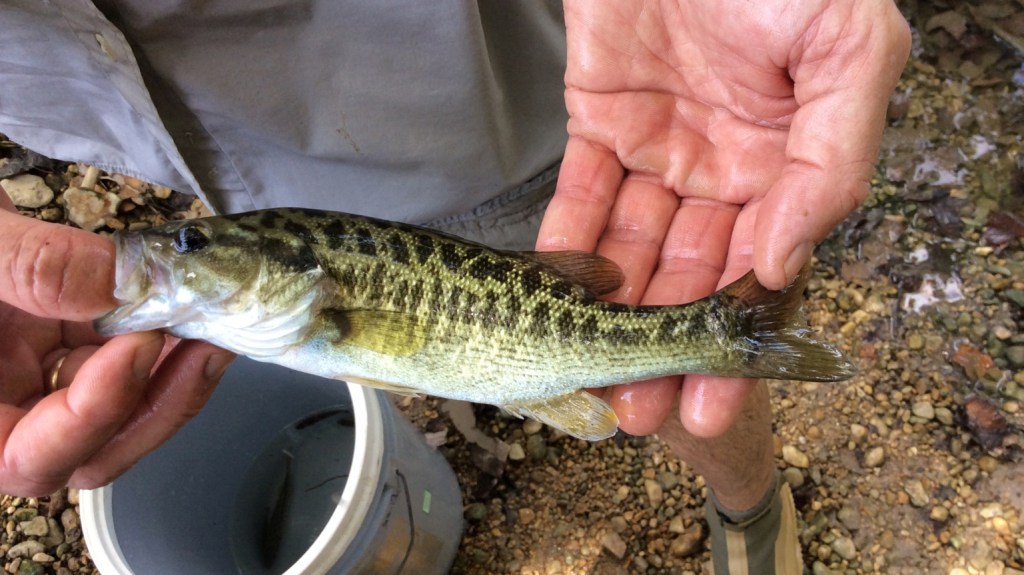To an angling observer, it might look like we’re smallmouth bass fishing. We’re drifting down a curving Texas river, casting streamers into riffles.
And when the hits come, it feels like smallmouth fishing. Aggressive takes, strong runs. When I first glimpse the fish in the clear water, you guessed it: The fish looks like a smallmouth bass, too.
Then it’s time for a closer look. This fish is more yellow, with prominent bars covering its body. There’s a superficial resemblance to a smallmouth, but this is a more striking creature. It’s the Texas state fish, the Guadalupe bass.
I’m with Nature Conservancy colleague and friend John Karges and fly fishing guide Alvin Dedeaux for a day pursuing Guadalupe bass, a species new to me. We’re in the Texas Hill Country, the only place on earth these fish swim.
Already I love these fish: attractive, hard-fighting and found in scenic, largely unvisited rivers.
However, these fish face a significant threat to their existence.
And that threat is, ironically enough, smallmouth bass.
Swamped by Smallmouth
Guadalupe bass are endemic to the Texas Hill Country, where they have historically thrived in a number of rivers. That is, until the smallmouth bass arrived.
Like too many invasive fish stories, the introduction of smallmouth bass was no accident. In the 1970s and 1980s, the Texas Parks and Wildlife Department stocked smallmouths, a popular sport fish. The smallmouths outcompeted and hybridized Guadalupe bass.

In some rivers, Guadalupe bass essentially disappeared. Researchers searching for the native fish in the Blanco River in the ‘90s couldn’t find a single pure specimen.
“It is embarrassing that we almost lost our state fish,” says Rachael Ranft, the Conservancy’s North Hill Country project director. “In some waters, we probably will never be able to completely recover the Guadalupe bass population. But there have been a couple of promising methods in restoring them.”
The Texas Parks and Wildlife Department began an ambitious stocking program, with the goal of releasing so many Guadalupe bass fingerlings into a creek that they essentially swamped the smallmouth bass population.
Biologists focused on Johnson Creek, a system that still had some Guadalupe bass, and had a dam in the tailwaters that prevented smallmouth migration upstream from the Guadalupe River. The stocking worked, and after several years Guadalupe bass accounted for 98 percent of the population.
“They are able to achieve this with continuous stocking,” says Ranft. “When they stopped stocking, the smallmouth bass came back. They are not able to leave that system alone.”

Some rivers, like the Blanco, had not been a priority for repatriation because no Guadalupe bass remained. Oddly enough, native fish restoration in the Blanco soon received a big boost from the most unlikely of sources, a devastating drought.
Salvation in a Drying Stream
Texas’ 2011 drought made national news as it led to increased wild fires, poor range conditions and drying rivers. Drying rivers are generally not considered a boon to fish conservation. But in this case, they may have changed the future for Guadalupe bass in the Blanco River.
The Blanco River’s halfway point is called “The Narrows,” a section of river that is a pinch point with steep bluffs on each side and a series of waterfalls, creating a barrier to fish passage except during flooding.
During the drought, the Upper Blanco above the falls severely dried up, with a series of disconnected pools the only remaining water. This concentrated nearly every fish in the upper river. Biologists saw an opportunity.

They electro-shocked and seined each pool, removing all smallmouth bass and other non-native fish. Due to the natural fish barrier, they were essentially able to remove invasive species from a large stretch of river.
In April 2012, heavy rains had the river flowing again. Biologists stocked approximately 105,000 Guadalupe bass , followed by 122,,000 more in 2013. They also stocked the river below The Narrows with Guadalupes, even though smallmouths couldn’t effectively be removed there.
A river survey in 2014 revealed that the upper river had a 100 percent pure Guadalupe bass population; the lower river was 50 percent Guadalupes, and stocked fish were already reproducing successfully.
Then came a catastrophic 2015 flood that created temporary fish passage over the waterfalls. “But even that flood brought really good news,” says Ranft. “The upper river was still 100 percent Guadalupes, and about 55 percent below the falls.”

This spring Ranft joined the Texas Parks and Wildlife Department in additional stocking of the river, with 55,794 fingerlings released.
“The goal is to someday not have to stock the river at all, to have a self-sustaining population,” she says. “The downstream population may never be entirely Guadalupe bass, but the upper river could potentially have a thriving population of native fish that would potentially supply the lower half of the river.”
And this restoration could also be replicated on other rivers. In some rivers, Guadalupe bass face additional issues, like dams. They fare better in flowing waters with lots of riffles, so dammed water is not ideal habitat. “We’re working to find solutions for landowners so they can get the same benefits of dams while restoring fish habitat,” she says.
While there are some anglers who would still rather fish for smallmouths, Ranft says most she encounter now recognize the uniqueness of the Guadalupe bass fishery. “They’ve been very supportive,” she says. “This is a special fish, found only here. More and more anglers see that as very appealing.”
In Search of Guadalupes
I’m always interested in a new fishing experience, so when I spoke at a conference in Austin earlier this year, I couldn’t pass up the opportunity to join my colleague John Karges for a couple days of Hill Country fishing.

After a day of catching largemouth and white bass, we joined Alvin Dedeaux, a guide who specializes in Guadalupe bass. While Texas is a bass-crazy state, a lot of the fervor is focused on largemouths on reservoirs. We would not be seeing the bass boating crowds today, Dedeaux promised. We’d likely have the river to ourselves.
We did. Drifting along, we cast into the riffles, with nary a fish to be found. Just before taking a lunch break, I hooked (and lost) two Guadalupes – a hopeful sign. And soon our luck changed, as a fish hammered my streamer and I finally had a Guadalupe bass alongside the boat.
Karges soon followed, and soon we were hooking fish in all likely habitat. We were fishing a river that never lost its Guadalupe bass population, and the fish were plentiful. “Most anglers still ignore them,” says Dedeaux.
The afternoon was winding down and the bites had slowed. “Give it a few more casts, let’s get one more,” Dedeaux said.
![IMG_3091[1]](https://blog.nature.org/wp-content/uploads/2016/06/IMG_30911.jpg)
The next cast my fly hit a small whirlpool and – wham! – a nice fish slammed my fly. My rod buckled over but a few minutes later we had a bass in the net. “Perfect,” Dedeaux said, the sun setting over the river.
I released the bass, grateful to encounter another native species with my fly rod. Long may the Guadalupe bass swim the Hill Country, and may they reclaim their home rivers from our fishy mistakes.




Matthew,
This is good information to know and I really appreciate your reporting it. I fish the Colorado river near Bastrop and the Guadalupe river below Canyon and both rivers have Guadalupe bass or their hybrids between Smallmouth or Largemouth bass. In your report you mentioned other rivers having the hybrid/cross (being mostly the smallmouth bass) which is what I’ve caught below Canyon in the Guadalupe River along with trout. see: https://youtu.be/N3Mhab2VjmU?t=7m15s
The bass out of the Colorado river below Austin and on down to Bastrop seem to be much better defined as either a Largemouth or a Guadalupe bass. TPWD seldom stock largemouth bass directly into river systems but the bass do move from the lakes they do stock with mostly Florida strain bass. Is there any evidence to suggest the Guadalupe bass crosses with the Largemouth bass?
Hi William,
Thanks for your comment. Guadalupe bass and largemouth bass do not hybridize. Hope you enjoy your native bass!
Matt
Matt, do you happen to know why there is a bag/size limit on smallmouth? It seems that these limits only serve to keep smallmouth in our rivers, and thereby increasing hybridization.
I am stoked my Texas brothers have the same almost weepy endearment toward the Lonestar indigenous black bass strain. We’re a odd group of outsiders that share the same sentiment over our Micopterus Coosae. Georgians well up over Shoal Bass as Floridians put a right hand over their hearts when a Suwannee Bass shows. Awesome article.
So, you expend all this effort to restore the fish and the you hunt and kill them. This is conservation? Sounds like a plan to maintain a population just for anglers and their “sport”.
Are you implying that you can’t do both? Thanks to Anglers and Hunters, we have restored and maintained wildlife for all to enjoy, even non-hunters/fisherman.
I have easy entry onto Pedernales River about 3 miles upstream from JohnsonCity. Happy to accommodate stocking effort of Guadalupes into our large and deep pool.
We have had Guadalupe Bass in Brewington Creek in Bandera County along Brewington Creek Road.